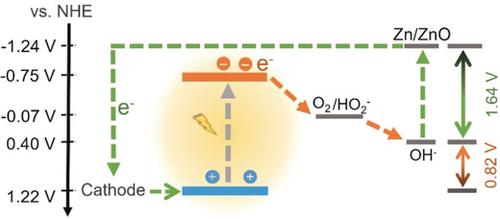当前位置:
X-MOL 学术
›
Angew. Chem. Int. Ed.
›
论文详情
Our official English website, www.x-mol.net, welcomes your
feedback! (Note: you will need to create a separate account there.)
Photoinduced Oxygen Reduction Reaction Boosts the Output Voltage of a Zinc-Air Battery.
Angewandte Chemie International Edition ( IF 16.1 ) Pub Date : 2019-08-01 , DOI: 10.1002/anie.201905954 Dongdong Zhu 1 , Qiancheng Zhao 1 , Guilan Fan 1 , Shuo Zhao 1 , Liubin Wang 1 , Fujun Li 1 , Jun Chen 1
Angewandte Chemie International Edition ( IF 16.1 ) Pub Date : 2019-08-01 , DOI: 10.1002/anie.201905954 Dongdong Zhu 1 , Qiancheng Zhao 1 , Guilan Fan 1 , Shuo Zhao 1 , Liubin Wang 1 , Fujun Li 1 , Jun Chen 1
Affiliation

|
Utilization of solar energy is of great interest for a sustainable society, and its conversion into electricity in a compact battery is challenging. Herein, a zinc-air battery with the polymer semiconductor polytrithiophene (pTTh) as the cathode is reported for direct conversion of photoenergy into electric energy. Upon irradiation, photoelectrons are generated in the conduction band (CB) of pTTh and then injected into the π2p * orbitals of O2 for its reduction to HO2 - , which is disproportionated to OH- and drives the oxidation of Zn to ZnO at the anode. The discharge voltage was significantly increased to 1.78 V without decay during discharge-charge cycles over 64 h, which corresponds to an energy density increase of 29.0 % as compared to 1.38 V for a zinc-air battery with state-of-the-art Pt/C. The zinc-air battery with an intrinsically different reaction scheme for simultaneous conversion of chemical and photoenergy into electric energy opens a new pathway for utilization of solar energy.
中文翻译:

光诱导的氧还原反应提高了锌空气电池的输出电压。
太阳能的利用对于可持续发展的社会非常重要,并且在紧凑型电池中将其转化为电能具有挑战性。在此,据报道以聚合物半导体聚三噻吩(pTTh)为阴极的锌-空气电池将光能直接转化为电能。辐照后,在pTTh的导带(CB)中产生光电子,然后将其注入O2的π2p*轨道中,以还原为HO2--分解为OH-,并在阳极处驱动Zn氧化为ZnO。在经过64小时的充放电过程中,放电电压显着增加至1.78 V,而无衰减,这与采用最新Pt的锌空气电池的1.38 V相比,能量密度增加了29.0% /C。
更新日期:2019-08-01
中文翻译:

光诱导的氧还原反应提高了锌空气电池的输出电压。
太阳能的利用对于可持续发展的社会非常重要,并且在紧凑型电池中将其转化为电能具有挑战性。在此,据报道以聚合物半导体聚三噻吩(pTTh)为阴极的锌-空气电池将光能直接转化为电能。辐照后,在pTTh的导带(CB)中产生光电子,然后将其注入O2的π2p*轨道中,以还原为HO2--分解为OH-,并在阳极处驱动Zn氧化为ZnO。在经过64小时的充放电过程中,放电电压显着增加至1.78 V,而无衰减,这与采用最新Pt的锌空气电池的1.38 V相比,能量密度增加了29.0% /C。















































 京公网安备 11010802027423号
京公网安备 11010802027423号